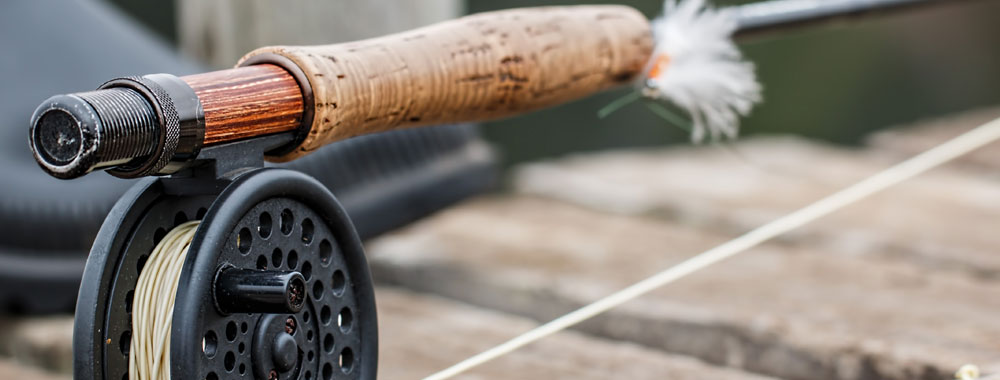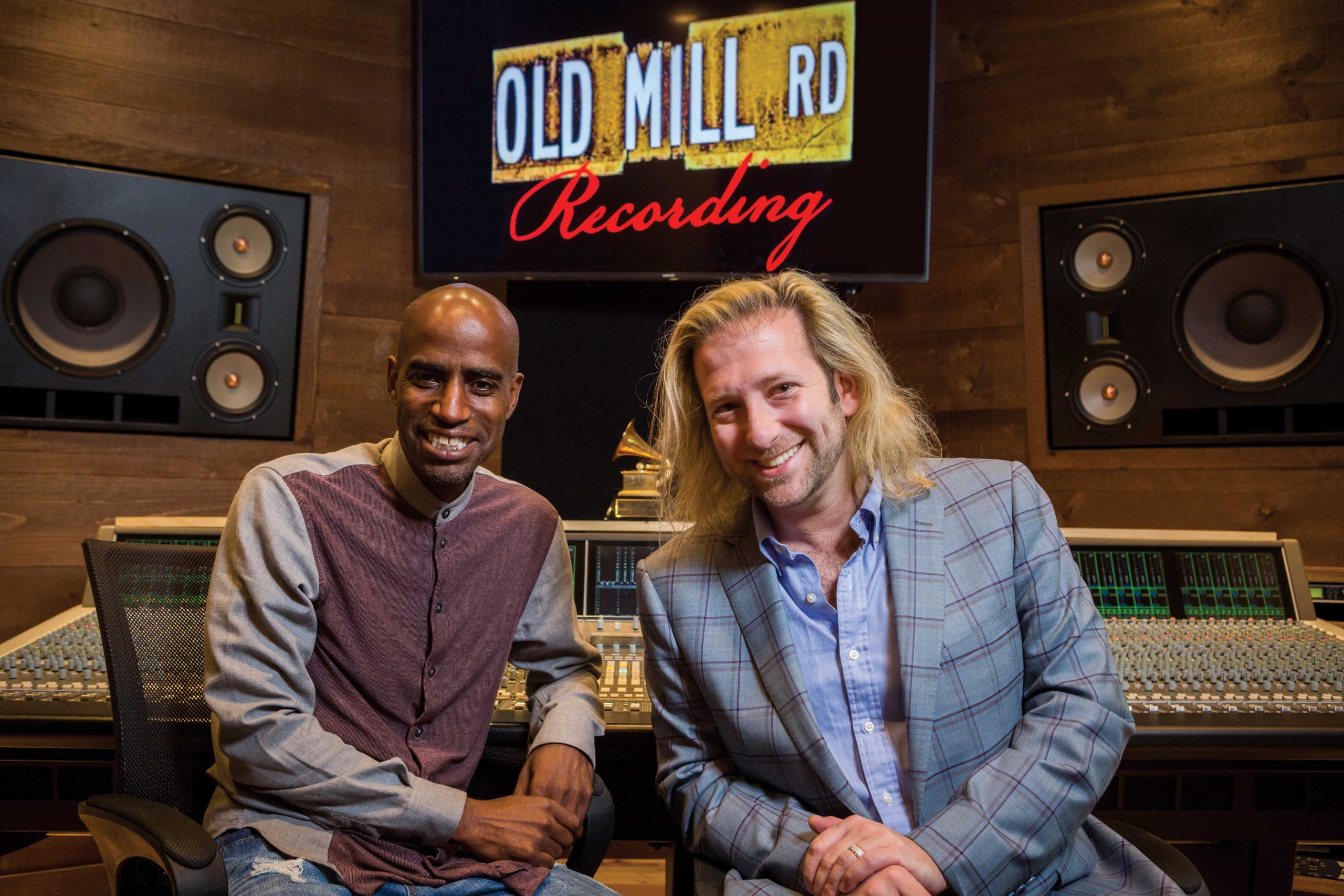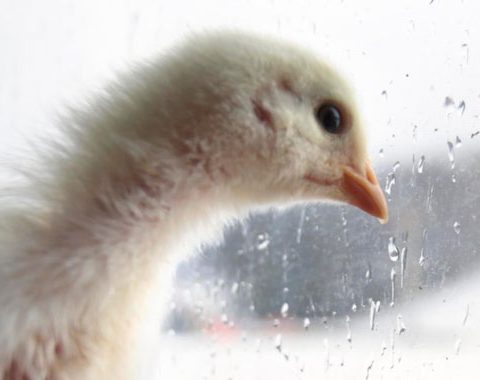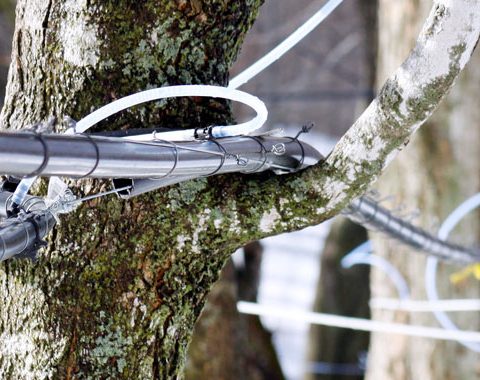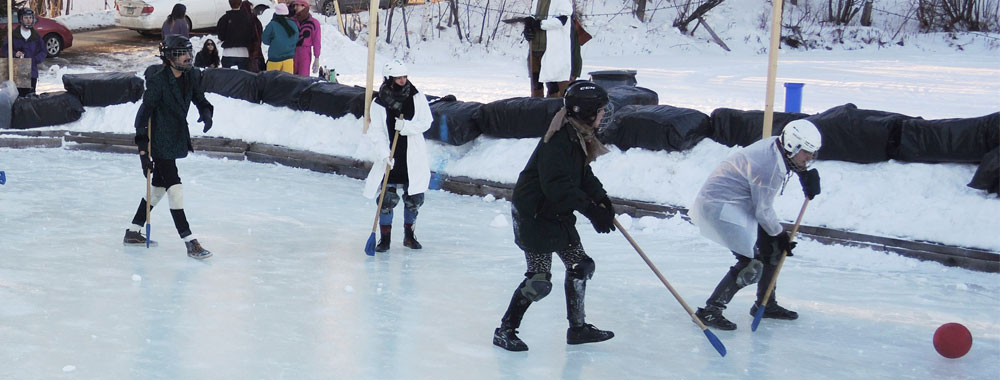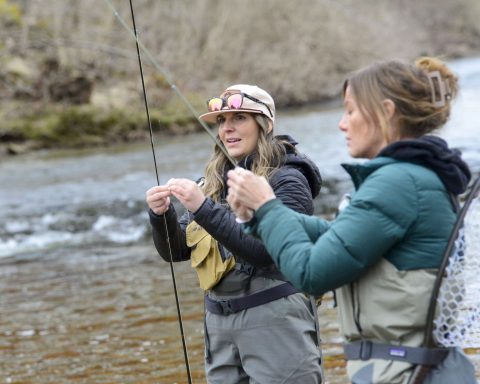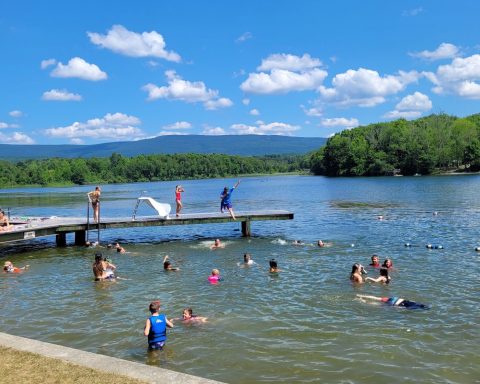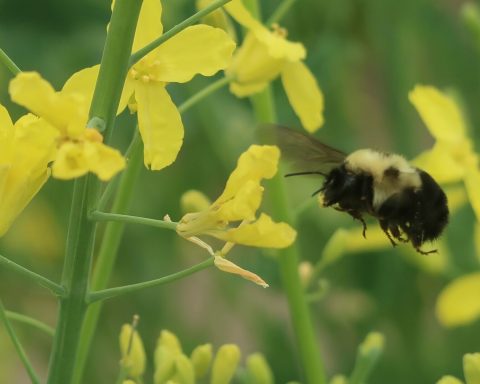
By Greg Sukiennik
Imagine a moment when all the cares of the world and your life — the job, the mortgage, all of it — disappears, and all that’s left is you and your natural surroundings.
It doesn’t require medication, virtual reality goggles or a sensory deprivation tank.
But you will need a fly fishing rod and reel, a few flies, and a commitment to learning a few skills in a world where you need to learn how to think like a fish.
That’s the magic of fly fishing, say the sport’s teachers and advocates. It draws you in so deeply, as you scan the water for the places fish loiter while awaiting their next meal, that the rest of the world disappears.
“It’s so meditative. It really is an activity that forces one into being present,” says Whitney Milhoan, the executive director of Casting for Recovery, a Manchester, Vt.-based nonprofit that helps women recovering from breast cancer through fly fishing adventures.
Whether it’s untangling line or reading the water for where the fish are lurking, “you’re almost forced to let your mind rest and let go of all the other stressors of the outside world,” Milhoan says.
When you’re thinking like a fish, trying to find the “seam” in running water and scanning the water surface for evidence of where the food is, you’re not thinking about the mortgage, the car repair or the job. You’re at one with the environment that surrounds you — a literal statement if you’re wearing waders and standing in thigh-high water.
Harry Desmond of Berkshire Rivers Fly Fishing has seen how fly fishing relaxes people while leading casting lessons and excursions.
“I get a lot of city folks who stay in the Berkshires, people who are rookies at fly fishing,” Desmond says. “They’re full of energy and kind of hyper. They want to know where we’re fishing, they’ve already got their waders on.
“Get them into the water, and after an hour, you see folks let go. You can see it, you can feel it — they let go of the daily grind. I’ll hit people with a question when I see they’re in the zone — I’ll ask ‘What are you thinking?’ Ninety percent of the time they’ll say ‘Oh, nothing.’”
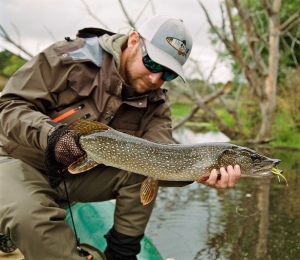
But isn’t fly fishing difficult to get into? All that equipment? All those fancy hand-tied flies? Isn’t it kind of expensive?
Not so. In fact, it’s never been easier to get started in the sport.
“Light years easier, “ says Orvis marketing manager Tom Rosenbauer, who got started 50 years ago as a boy with a few library books and time to learn from his own mistakes. “Today, with much better books and thousands of internet videos and schools it’s a whole different story.”
And the Berkshires and Southern Vermont are great places to get started.
So let’s start where modern fly fishing in the United States began: Manchester, Vermont.
Here, nestled between the Taconic and Green Mountain ranges and alongside the Battenkill River, the legacy of Charles F. Orvis and his family is everywhere. The company he founded in 1856 as a mail-order specialty firm is headquartered just down the road in Sunderland; it’s now owned by the Perkins family, which purchased the firm in 1965. The company’s flagship store, complete with trout ponds, is at 4180 Main Street (Historic Route 7A), within strolling distance from several hotels and inns.
You can immerse yourself the sport’s history here. The American Museum of Fly Fishing sits just south of the flagship store, and contains an informative permanent exhibition laying out the long history of the sport, and how innovation has fueled the constant evolution of equipment. Behind the store is the Orvis Rod Shop and Factory, which hosts daily tours that showcase the marriage of high-tech and human craftsmanship that goes into making the company’s signature product.
But if you’re getting started in fly fishing, you’ll want to cross Main Street and check out the Orvis Fly Fishing School.
The school’s Fly Fishing 101 classes, established more than 50 years ago, are an excellent way to start, as the company employs a panel of well-respected anglers and teachers who will show you the finer points of casting, tying knots and figuring out where to find the fish. Anglers from around the world travel to Manchester to learn and sharpen their skills and try their luck in the Battenkill River, well-known for its challenging brown trout fishing and plentiful brook trout.
This spring and early summer, Orvis plans to offer free Fly Fishing 101 and 201 instruction on weekends starting April 22 and running through the end of June at its retail locations. The classes come with a nice perk: A free Trout Unlimited membership, which provides access to a grassroots organization that promotes the conservation and preservation of coldwater fisheries and habitats.
Why go to the trouble of starting with a school, or a guide? For starters, you’ll learn from someone who knows what they’re doing, and that’s always a good idea. Second, they’ll often provide all the fishing gear you’ll need, so you can try before you buy.
Rates for the Manchester school run between $140 and $489; see http://www.orvis.com/fly-fishing-schools for details.

Ideally, whomever you go fly fishing with that first time — a guide or an experienced friend or family member — will spend a lot of time teaching you the basics so you can build a foundation from which to enjoy the sport.
“Hiring a guide the first time going out is a great idea,” says Desmond of Berkshire Rivers Fly Fishing, whose introductory two-hour casting clinic costs $100 and first-time wade-in costs $250 for six hours, with all the gear you’ll need included.
“With beginners, you teach, teach, teach. Get them out on the water and I guarantee that person, after the first time, is going to leave with confidence,” he said.
What sets fly fishing apart from spin reel fishing is also what presents hurdles for people who think it’s too hard or too time-consuming to learn: Successfully getting the fly into the water.
Other than the use of hand-tied lures, the main difference between fly fishing and spin fishing is that fly fishing line is weighted because the fly weighs close to nothing. (In spin fishing, it’s the weighted lure that gets tossed and pulls the line with it.) Combined with the correct fly-casting motion, the weight of the line loads the rod in a bend in the back cast and then in the forward motion the rod unbends, sending energy forward into the line and propelling it forward. The trout fly, weightless, merely goes along for the ride out onto the water. So the art of casting — getting the fly into the water — is the biggest hurdle that new anglers face, according to Orivis fly fishing instructor Truel Myers.
The good news is there’s plenty of instruction available in the Berkshires and Southern Vermont for anglers of all experience levels.
“Any kind of motion, like an athletic endeavor, can be a hurdle to some people,” Myers said. “But it’s something most anybody should be able to do.”
And like a lot of things in life, the secret is not overdoing it.
“One of the biggest issues with people casting is they try to work too hard at it. They don’t let the tackle do the work for them,” Myers said. “If they use the proper mechanics, the equipment is going to do most of the work for them. Once that’s figured out, it makes it a lot easier.”
“The biggest hurdle is muscle control,” so that one can get the timing of when to release the line during the forward part of the cast, Myers said. “People tend to grip the fly rod way too tight. Their whole body is tense.”
If all that has you worried about learning to cast properly, relax, Myers says. While casting is important, perfection for it’s own sake is not the goal.
“What I tell people is don’t worry about the cast. It’s about getting the fly in the water,” Myers says. “Your casting is going to come. It’s like riding a bike.”
That said, instructors agree: Practice is the best way to get good at the sport’s disciplines and truly enjoy it.
“It’s all about building a foundation,” Desmond says. “Hopefully, you’ll go out on your own and struggle with it. Like playing an instrument or anything else, it takes time.”
The Berkshires and Southern Vermont have something else that’s essential for fly fishing: Waterways upon which to enjoy it.
The Battenkill River in Vermont and New York, the West and Connecticut rivers in Southeastern Vermont, and the Hoosic, Housatonic, Deerfield, Westfield and Farmington rivers in the Berkshires all offer challenges to suit anglers of varying skill levels.
“Tiny streams are everywhere in the Berkshires,” Desmond says. “For someone looking for a bigger step up, the Housatonic fishes very well. The Deerfield fishes well, but it draws a lot of people.”
If there’s another mistaken perception about fly fishing, it’s that the sport is a closed loop — an old boys club of experienced, well-heeled sportsmen.
Not so. Myers, Desmond and Peter Nardini at the American Fly Fishing Museum all say they’ve seen an increase in younger anglers. And Myers and Milhoan, of Casting for Recovery, point to increased participation by women.
Truth be told, women have a long and notable history in the sport.
During his guided tour of the museum, Nardini explains the vital role played by Mary Orvis Marbury, Charles F. Orvis’ daughter, in creating a national language for the sport. Maybury was given responsibility for the fly tying operation of the family business at the age of 20. And her book “Favorite Flies and Their Histories,” published in 1892, combined with her photography and fly exhibition at the 1893 Chicago World’s Fair, helped standardize names that had previously varied by region. In one of the photographs, women can be seen at river’s edge with fly rods in hand.
“I think the reason it’s a powerful vehicle for healing in women is it’s a chance to stop for 30 minutes, two hours or half a day and focus on pure activity and enjoy the meditative properties of a simple connection with nature,” Milhoan said.
“There used to be this stigma about fly fishing that it was a good old boys club and to be part of it you had to be affluent or have special gear or a perfect cast. What we have seen in organizations like ours is genuine effort from brands in the business to demystify that, break it down and lower barriers to entry.” •

